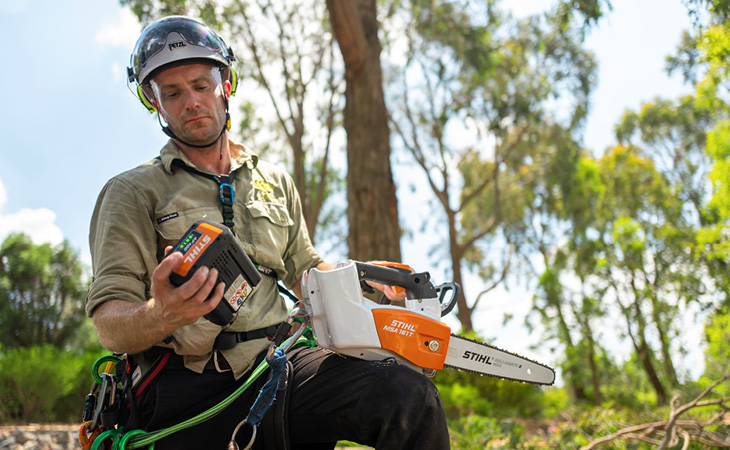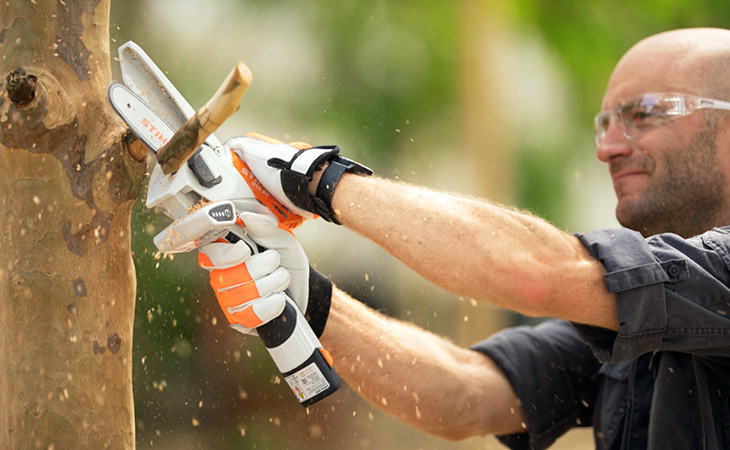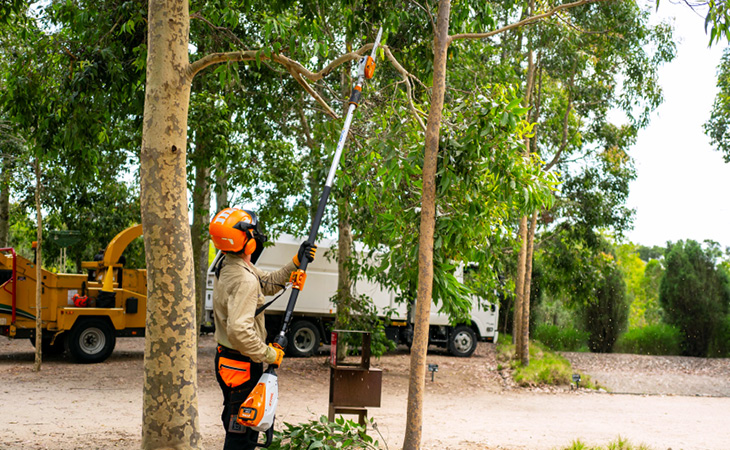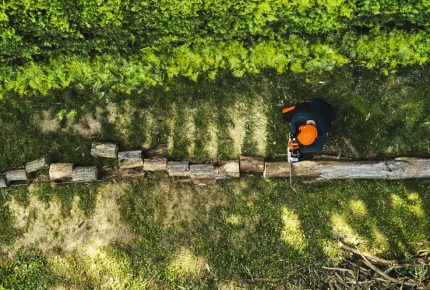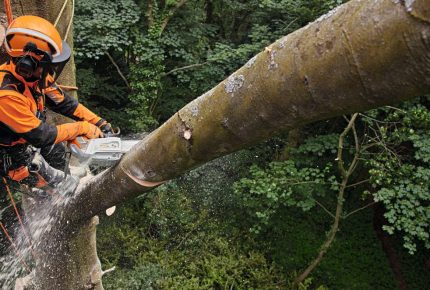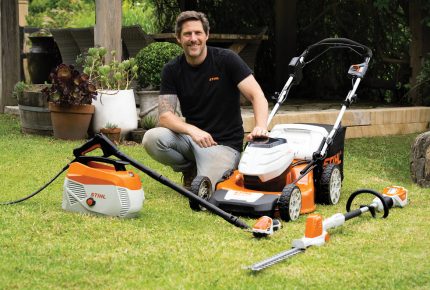
#Inspiration
Autumn Reboot: Tree Maintenance & Pruning with Royal Botanic Gardens
Autumn is an important time in the management calendar of any garden, and it’s an especially pivotal time for Royal Botanic Gardens in Cranbourne, Victoria. The stunning expanse of native flora and fauna, characterised by an unmissable Red Sand Garden, is dedicated to the conservation of more than 25 endangered, rare and threatened species.
For the Garden’s horticulture and arboriculture teams, this time of year calls for an ‘Autumn reboot’ to revive plants after the long hot Summer. ‘In Australia we have a Summer dormancy due to heat and dryness,’ says John Arnott, Horticulture Manager at the Gardens. ‘Autumn is the trigger for things to start to regrow and rehydrate… It’s prime time for facilitating a range of garden tasks.’
From March through to May, moderate rainfall ensures plenty of moisture in the soil. And without the heat stress, healthy sap flow resumes. This makes it a great time for tree maintenance and pruning, as STIHL’s resident garden expert Charlie Albone found out during his recent visit.
Tree Maintenance
There are a number of good reasons to prune in Autumn. From the gardens, it’s a balance of safety, aesthetics and trying not to fight a tree’s natural instincts to grow. It comes down to removing the three D’s – dead, damaged and diseased.
‘For Australian trees, a lot of their active growing season is about to start taking place in Autumn. It’s an ideal time to prune’, says Charlie Carroll, Arboriculture Manager at the Gardens. ‘We’ll do structural pruning, reduction of fire loads, taking deadwood out over the path… and the reduction of fire laddering across canopies.’
With over 360 hectares of bushland, there is no shortage of pruning and tree maintenance jobs for Charlie and his team of professional arborists at the Gardens.
Canopy and weight reduction
The Gardens undertake frequent thinning of eucalypts in Autumn. Not only does this reduce fire risk, but canopy separation is a great way to manage possums by ‘breaking the bridges’ they use to scurry about. ‘Possums are creatures of habit,’ says Charlie. ‘When you change one small thing, it takes them a long time to re-adjust to the environment and build another habit. In that time, if the tree is healthy, you’ll get a lot of recovery.’
Canopies aside, weight reduction of limbs is also a major focus for the team, who take a preventative approach to tree management. ‘Weight reduction of larger limbs can improve the structure of a tree and reduce the likelihood of limbs failing.’
PRUNING
Structural pruning
With the dropping of leaves and debris in Autumn, arborists and gardeners can get a good look at the structure of a tree – particularly if it’s deciduous.
‘We start by looking on a ground level, then our inspection level goes up as we ascend,’ Charlie says. ‘Or, we use different types of machinery to do other assessments depending on what we see on ground level. But by the time you get halfway up there, a lot of the things that aren’t apparent from the ground become more obvious. There’s generally a lot more to do than you’d anticipate.’
Whether you’re pruning a smaller tree or managing large mature trees, a clear assessment will always ensure a better outcome.
Formative pruning
With plenty of sunlight and soil moisture, Autumn is a good time to plant and pot. With this comes the process of formative pruning. It’s a great way to set young trees up for success and prevent problems down the track.
Plant selection is also key: ‘A sensible practice is establishing tree stock,’ says John Arnott, Horticulture Manager. ‘From seed to senescence. Picking the right healthy stock from the get-go is key to developing good trees.’ While it might be tempting to raid the bargain section at your local nursery, sometimes it pays to be more selective.
The Bonsai Technique
Royal Botanic Gardens Cranbourne has a world-class reputation and this extends to their pruning methods. A prime example is the Seaside Gardens, a breath-takingly ornamental setting that celebrates Australia’s coastal plains. Lining the large body of still water are melaleuca trees, pruned using the Bonsai Technique.
‘An iconic element of the coast is that breeze and that prevailing wind that shapes and leans plants over, because of the salt spray,’ says John. ‘We’ve shaped, pruned and clipped to capture that look and feel… It miniaturises and almost abstracts nature.’
The technique begins as a formative prune, overseen by Nursery Team Leader Mandy Thomson. Mandy and the team plant seedlings at a 45 degree angle, then use secateurs to prune them to a couple of leaders, which encourages lateral growth. As the melaleucas grow, they keep this shape and become woodier. Eventually, they’re added to the tree line in the Seaside Garden.
Dead-wooding
It’s important to remove dead wood, especially in public places where overhanging branches can fall onto paths and cause obstructions, or pose a hazard to visitors. Not only that, they can attract unwanted pests and diseases.
When dead-wooding, it’s tempting to get rid of absolutely everything, but that can give you a staged look. The trick is to find a happy medium, in line with the objectives of the garden you care for.
Says Arboriculture Manager Charlie Carroll: ‘We try address a balance between people’s safety, fire loading, ecological concerns, and then the aesthetic look of the tree. We will leave as much as we can, within reason.’
Garden systems and processes
Maintenance calendar
The management calendar is key to the care of any garden collection, especially larger ones. With over 360 hectares including 10km of walking tracks, how do Royal Botanic Gardens schedule their tree maintenance?
‘There’s an overall program we run with an inventory of all the trees and tasks that need to be done. That’s the programmed work,’ says Charlie Carroll. ‘Then there’s always unprogrammed work – especially after storm events, there’s clean-up. It’s a combination of programmed pruning that comes from knowing your tree stock and what needs to happen to it, and then that reactive stuff after you get an event.’
Tree maintenance tools
The horticulture, arboriculture and nursery teams at the Gardens use everything from secateurs, loppers and hand saws through to chainsaws of all varieties and sizes. The tools used by these professionals is shifting with the evolution of new technologies.
‘We’ve gone battery at the gardens almost exclusively, until we absolutely need something bigger in cases where we’re doing removals or larger work,’ says Charlie Carroll. ‘They’ve revolutionised the industry because they’re lighter; they’re very precise – almost surgical.’
The lighter weight of battery tools carries more than one benefit for arborists. Not only is it easier on the body (reducing fatigue), but battery chainsaws don’t require a drop start, which is not ideal when they’re up a tree. ‘The STIHL MSA 161 T has changed my climbing life, you can’t beat it,’ says Charlie.
Paired with this chainsaw and others is the AP 200 battery, an upgrade on the AP 300. This makes the overall tool weight lighter, reducing fatigue and enhancing operator comfort over long periods of use.
Another key benefit of battery chainsaws is that they don’t spill fuel, which can erode climbing ropes. It’s why – when a petrol saw is required – Charlie likes to use STIHL BioPlus Chain and Bar Oil. ‘It’s biodegradable so if it spills, it’s a little gentler on the environment.’
When working from the ground, the team at the Royal Botanic Gardens Cranbourne use STIHL pole pruners. These provide longer reach for tasks that still require some height, while allowing for reduced effort (as the team do not have to climb the tree).
To receive more professional Autumn gardening tips from Charlie Albone’s visit to Royal Botanic Gardens Cranbourne, subscribe to the STIHL newsletter here.

